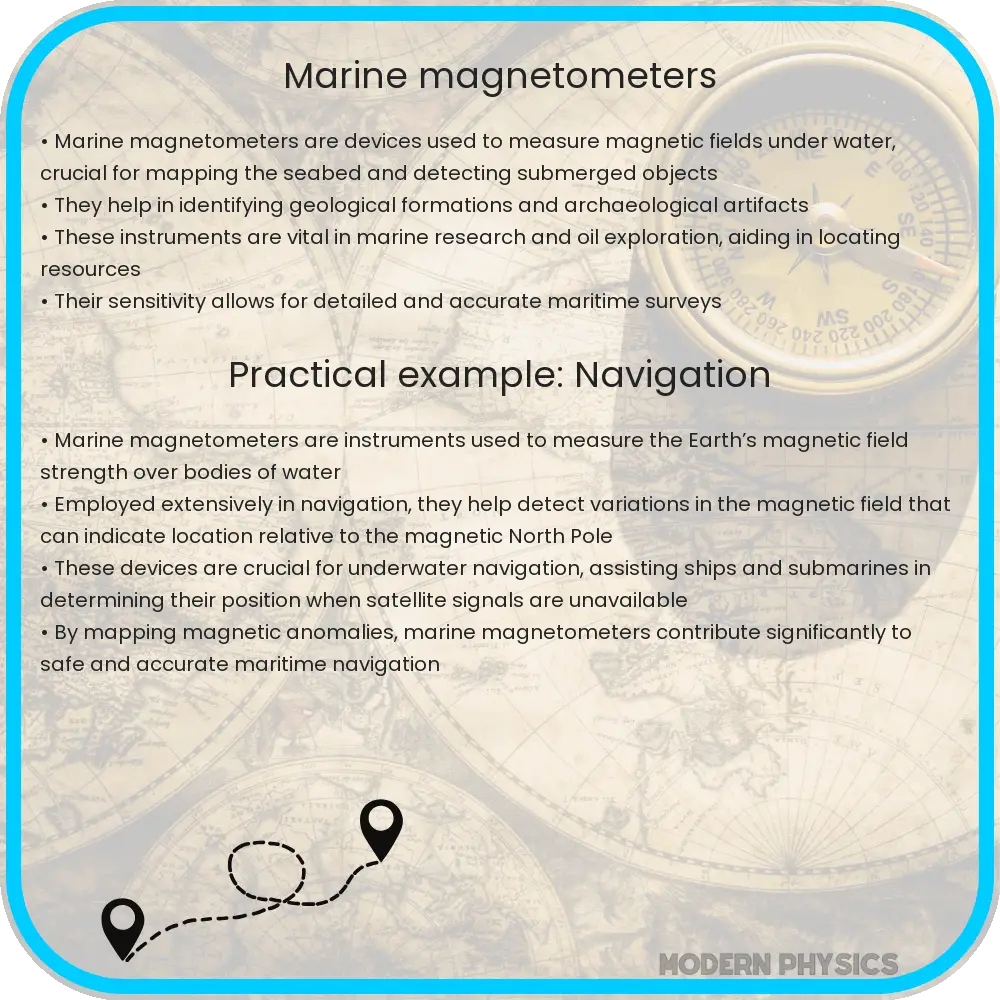Explore the use of marine magnetometers in measuring underwater magnetic fields for archaeological and geological surveys.

Understanding Marine Magnetometers: Precision, Depth, and Geophysical Data
Marine magnetometers are sophisticated instruments used to measure the magnetic field strength beneath the Earth’s surface, primarily underwater. These devices play a crucial role in a variety of marine applications, ranging from archeological surveys to finding submerged objects, and in the oil and gas industry for geological exploration. This article explores the workings of marine magnetometers, their precision, depth capabilities, and how they contribute to collecting geophysical data.
The Basics of Marine Magnetometers
A magnetometer, in general, measures the strength and direction of magnetic fields. Marine magnetometers are specifically tailored to detect anomalies in the magnetic field under the sea. Two common types of marine magnetometers are proton precession and cesium vapor magnetometers. Both varieties have distinct operating principles and are chosen based on the requirements of the survey, such as sensitivity, depth, and resolution.
- Proton Precession Magnetometers: These devices work by aligning the magnetic moments of protons in hydrogen atoms using an external magnetic field. When this field is suddenly turned off, the protons precess at a frequency that is proportional to the ambient magnetic field. This frequency is then measured to determine the magnetic field intensity.
- Cesium Vapor Magnetometers: Cesium vapor magnetometers operate by measuring the frequency of light absorbed by cesium atoms in a vapor state. The absorption frequency changes with variations in the magnetic field, providing a precise measurement of the magnetic field strength.
Depth Capabilities and Precision
The capability of a marine magnetometer to accurately measure magnetic fields at different depths is critical for deep-sea explorations and surveys. The technology behind these instruments allows them to detect magnetic anomalies from several kilometers away, which is vital in areas where deep-sea sediments are of interest.
Precision in magnetic field measurement is crucial, especially in applications like locating shipwrecks or underwater archaeological sites. Factors such as sensor sensitivity, noise level, and the method of data interpretation play significant roles in determining the precision of a marine magnetometer. Modern advancements in technology and data processing software have significantly enhanced the precision with which these measurements can be made.
Collection and Interpretation of Geophysical Data
Marine magnetometers do not just collect magnetic data; they also play a pivotal role in the interpretation of geophysical data. The anomalies detected by magnetometers often indicate the presence of ferromagnetic materials but can also suggest geological structures and boundaries. Interpretation of these data requires a thorough understanding of geological processes and may involve integrating data from other geophysical surveys such as seismic, gravitational, or sonar mappings.
Anomalies in magnetic data can be indicative of various geological and anthropogenic features, including:
- Underwater mineral deposits like iron ore or nickel.
- Shipwrecks and other historical artifacts made of ferrous materials.
- Submerged pipelines and cables.
- Geological structures such as basalt layers, which have a higher magnetic susceptibility than surrounding materials.
The data collected by marine magnetometers are usually displayed as a map of magnetic anomalies. These maps help researchers and engineers pinpoint specific features of interest and make informed decisions regarding further exploratory or recovery operations.
Technological Advances in Marine Magnetometers
As technology evolves, so do the capabilities of marine magnetometers. Recent advancements include the integration of GPS technology, which allows precise positioning of magnetic anomalies, and improvements in data transmission systems, enabling real-time data analysis even from remote locations. Additionally, the miniaturization of components has led to more compact and energy-efficient designs, expanding their operability and ease of deployment in challenging marine environments.
- Digital Signal Processing: Modern magnetometers employ sophisticated digital signal processing techniques that enhance the clarity of the magnetic field data, reducing noise and increasing accuracy.
- Autonomous Underwater Vehicles (AUVs): The deployment of AUVs equipped with magnetometers allows for unmanned, deep-sea missions, reducing operational costs and risks associated with manned explorations.
Applications in Marine Research and Industry
The usefulness of marine magnetometers extends beyond the basic detection of submerged objects and geological features. In environmental science, these instruments help monitor underwater volcanic activity and track changes in the Earth’s magnetism that might indicate impending earthquakes. In the industry, they are integral in laying submarine cables and pipelines, ensuring routes are clear of obstructions or archaeological importance.
Key sectors benefiting from marine magnetometers include:
- Environmental monitoring and research.
- Defense, for submarine surveillance and mine detection.
- Offshore construction and maintenance.
- Maritime archaeology.
Conclusion
Marine magnetometers are pivotal in unraveling the hidden mysteries beneath the sea’s surface. From aiding archaeological discoveries to enhancing oil exploration, these devices provide critical data that contribute to our understanding of the underwater environment. As technology advances, the scope of their applications widens, driving further innovations in marine exploration and environmental monitoring. The integration of these technologies not only makes deep-sea surveys more precise but also safer and more cost-effective, fulfilling the growing needs of various sectors reliant on marine resources.
Understanding and leveraging the capabilities of marine magnetometers not only supports scientific and commercial endeavors but also plays a significant role in preserving our maritime heritage and natural environment. With each technological advancement, we gain a clearer view of the ocean’s complex systems, making marine magnetometers an indispensable tool in the ongoing exploration of our planet’s final frontier.
